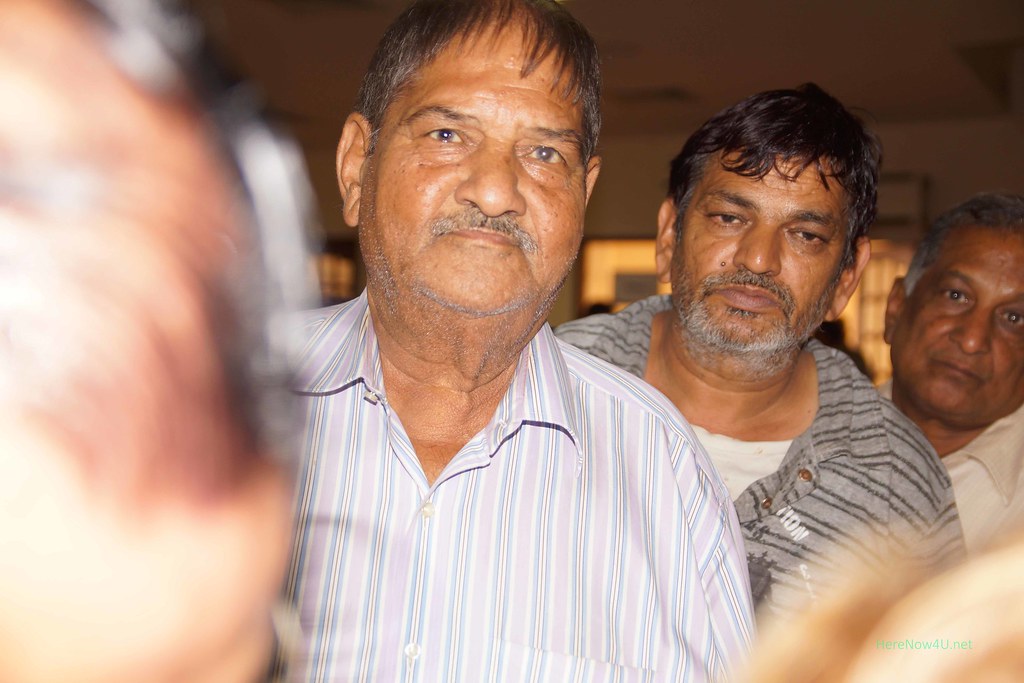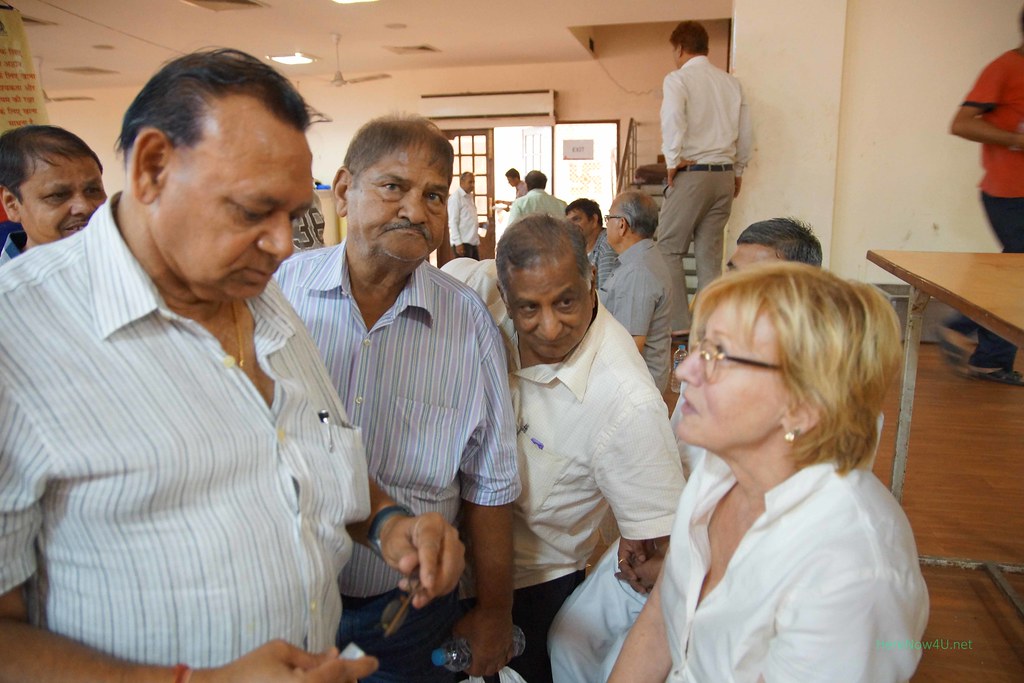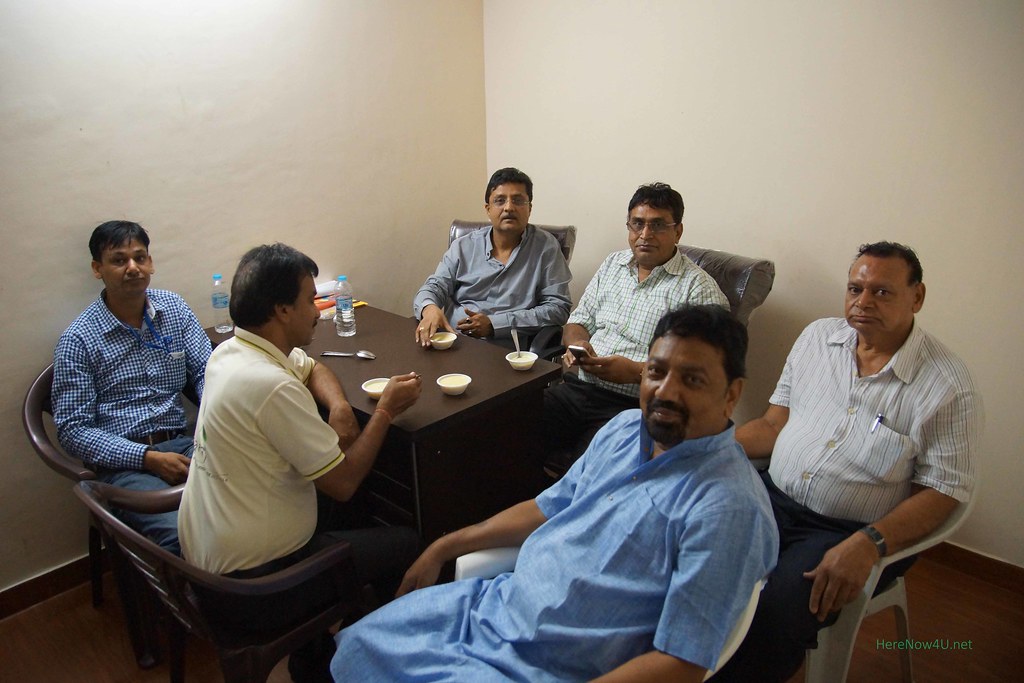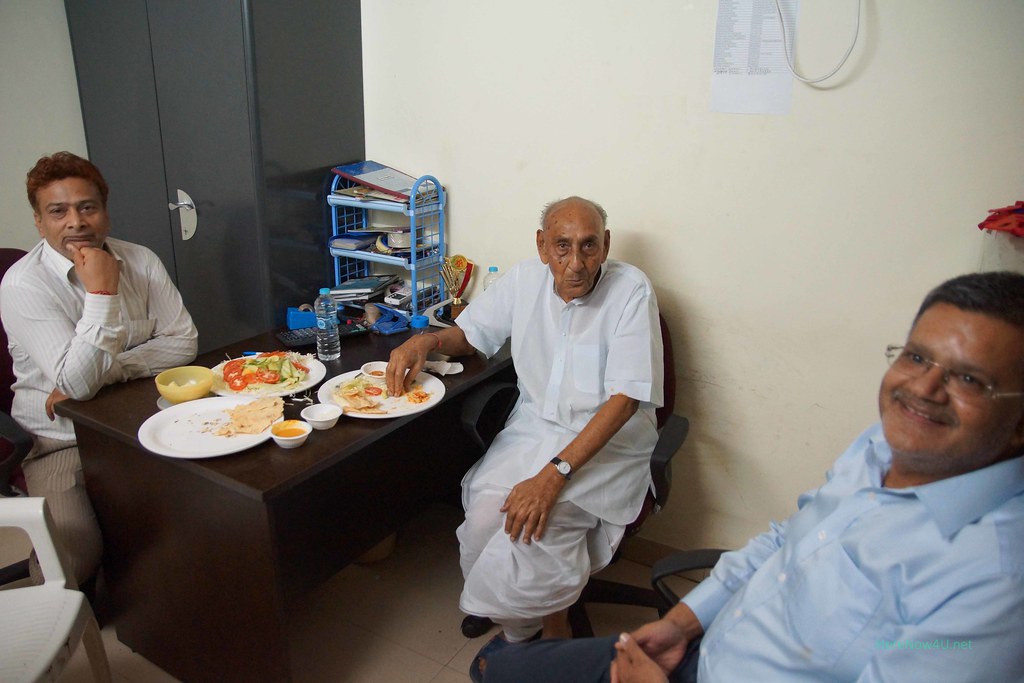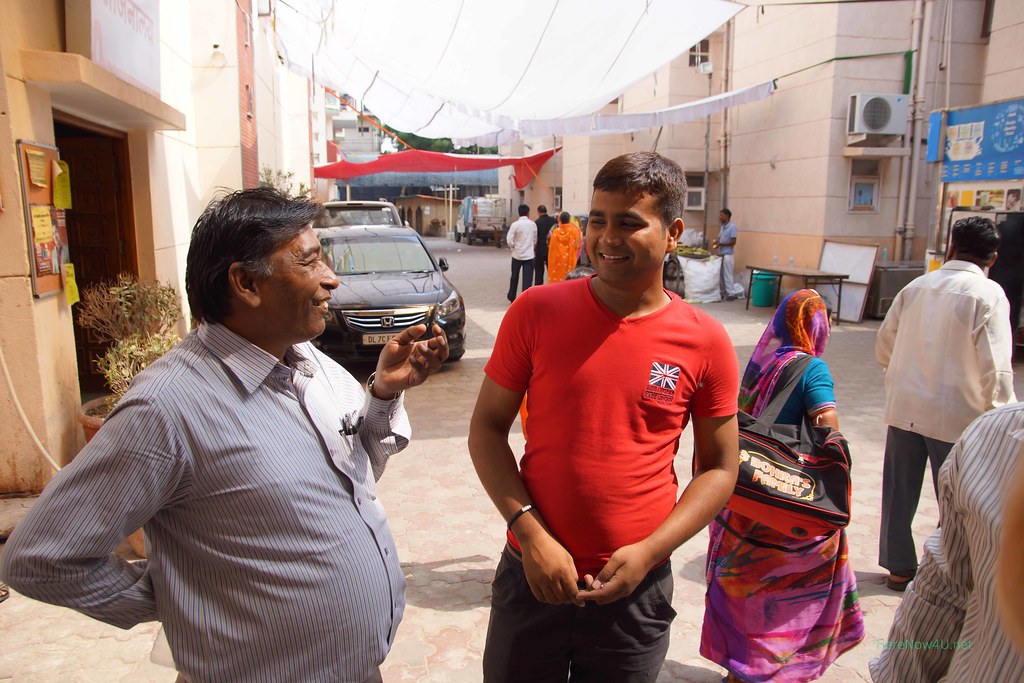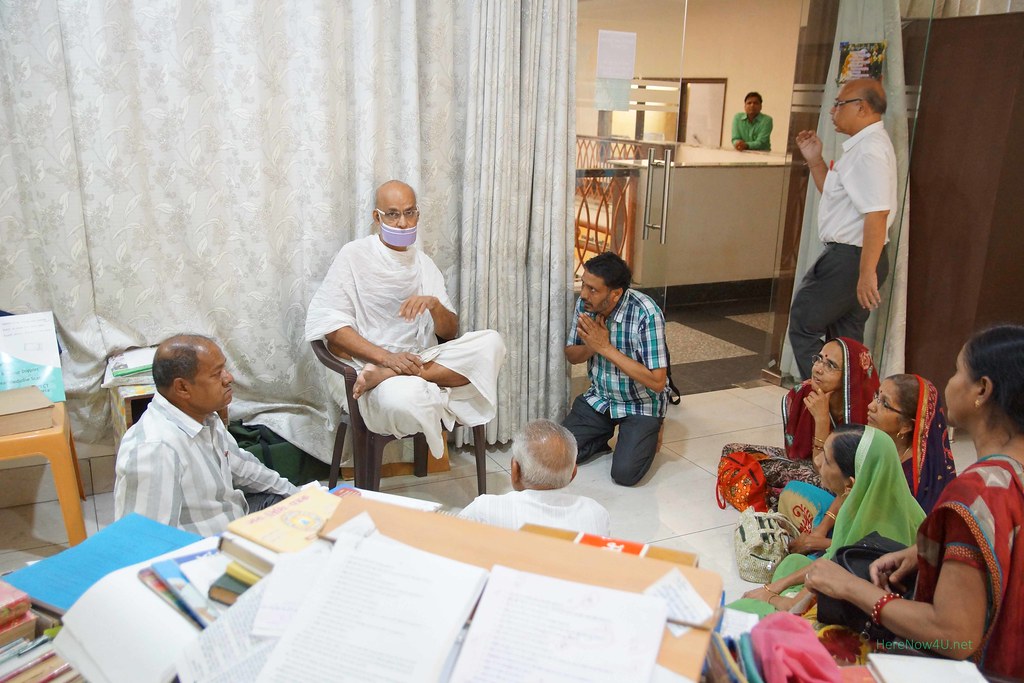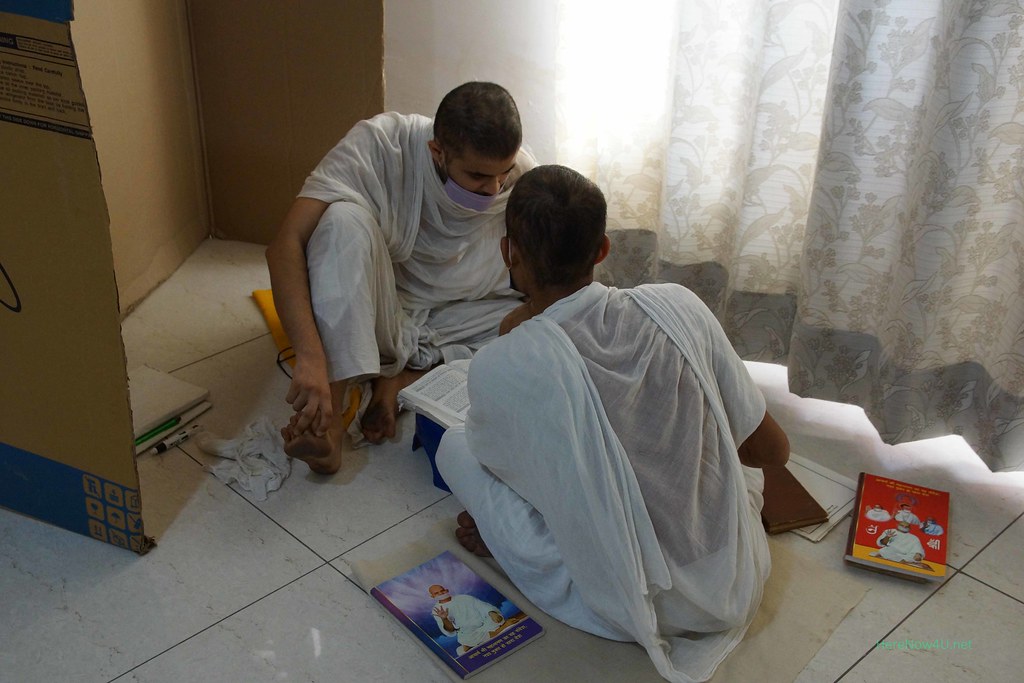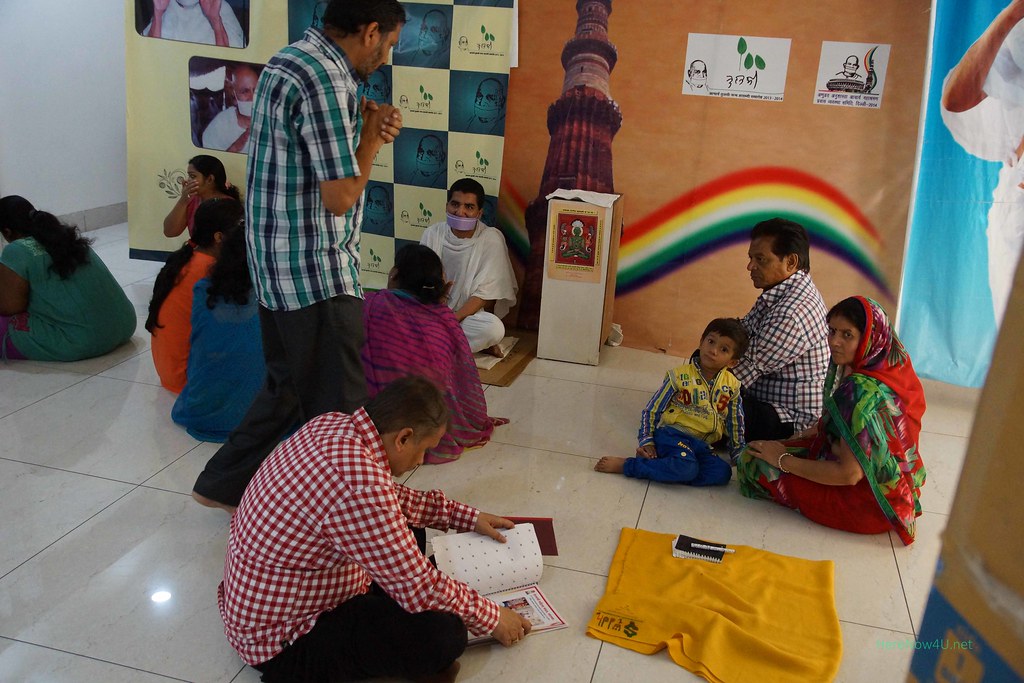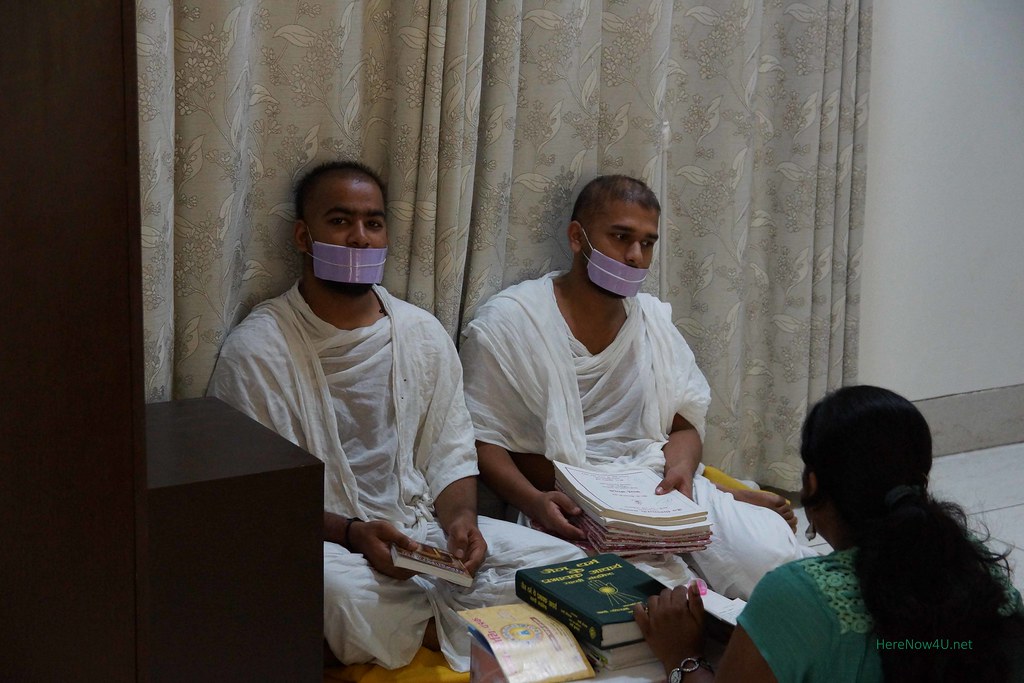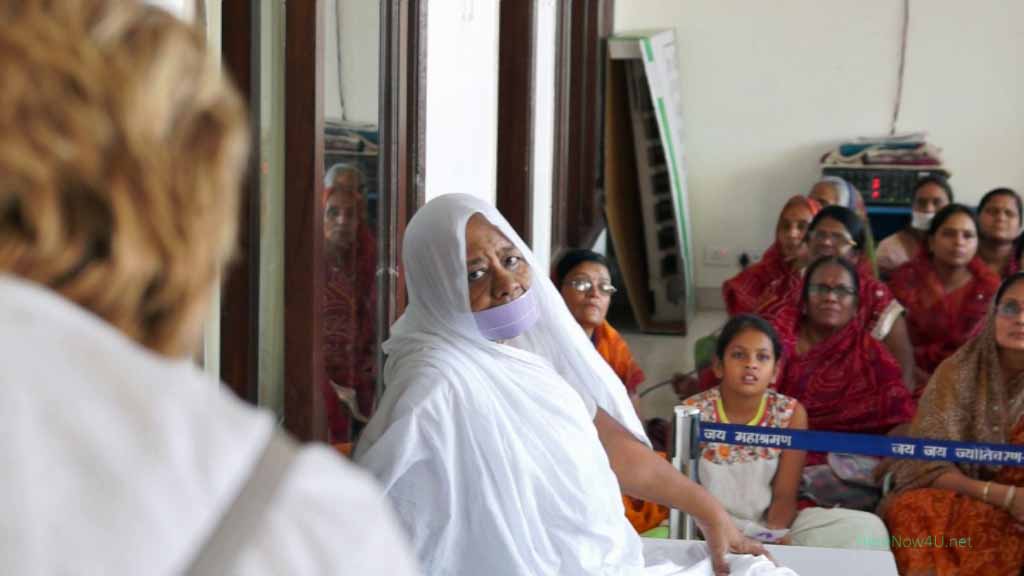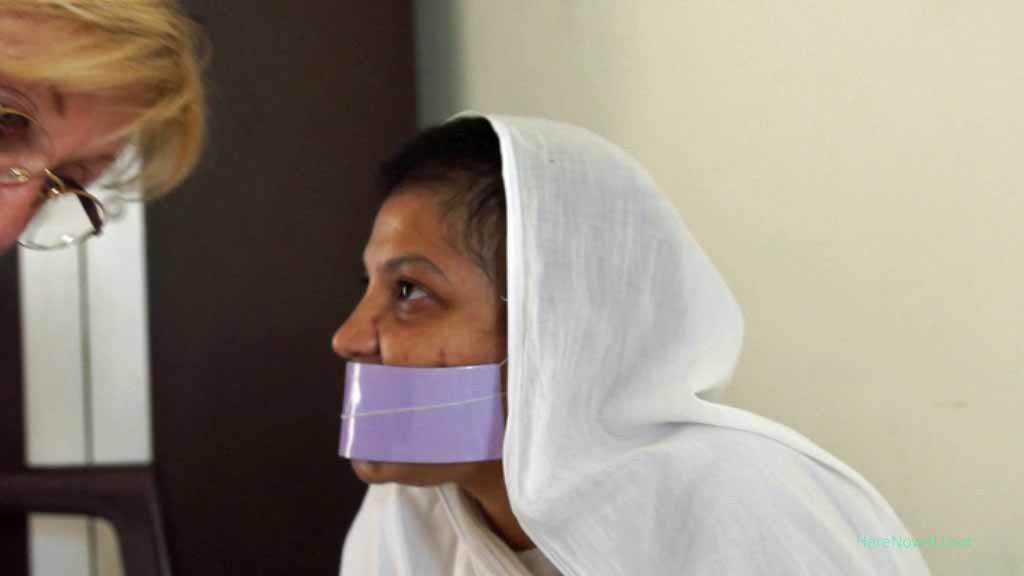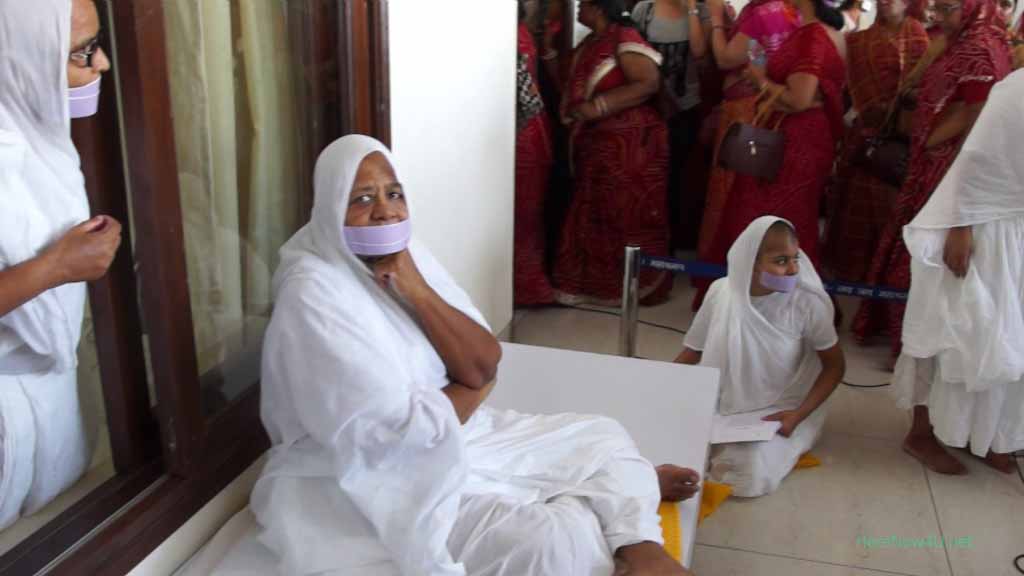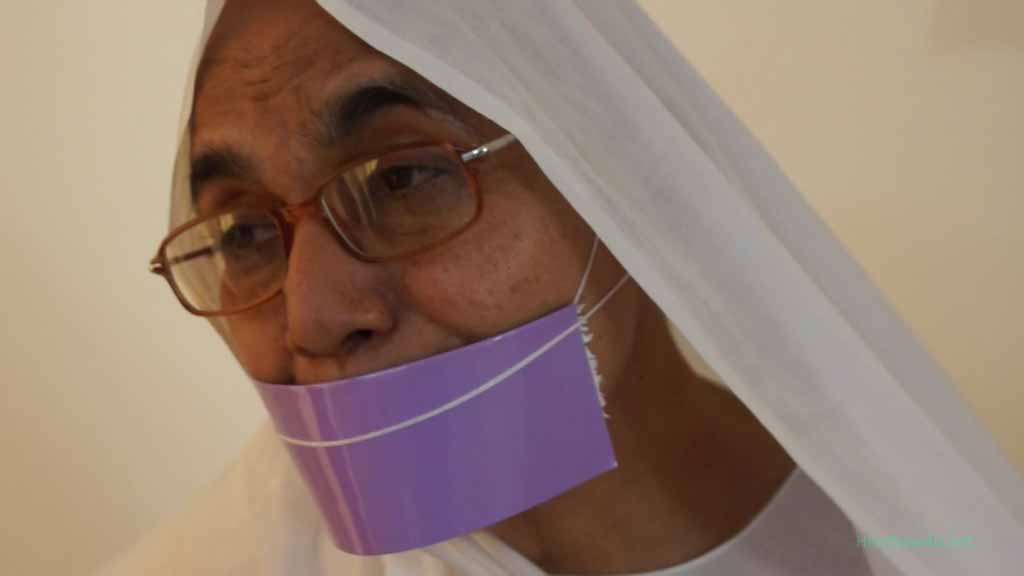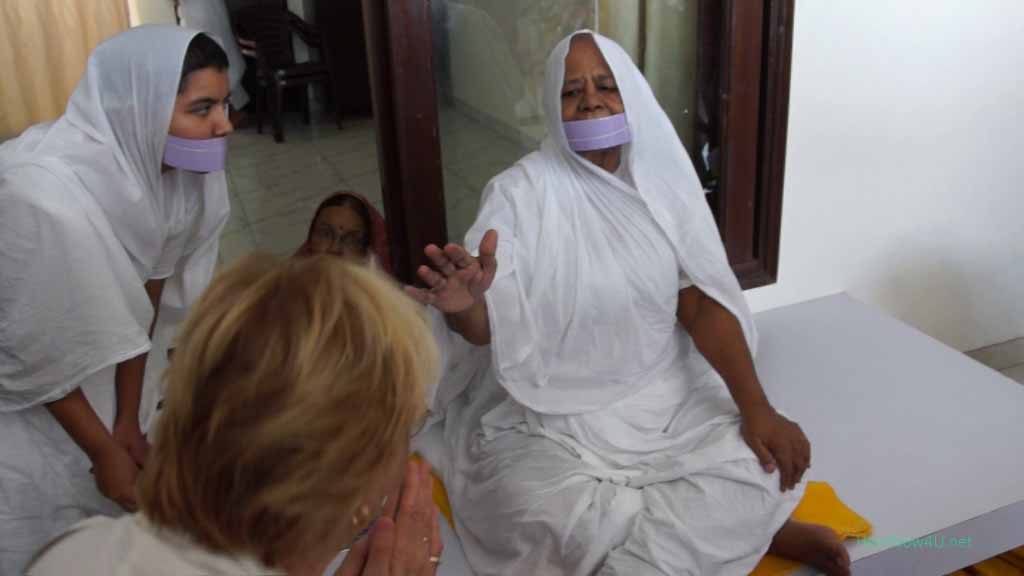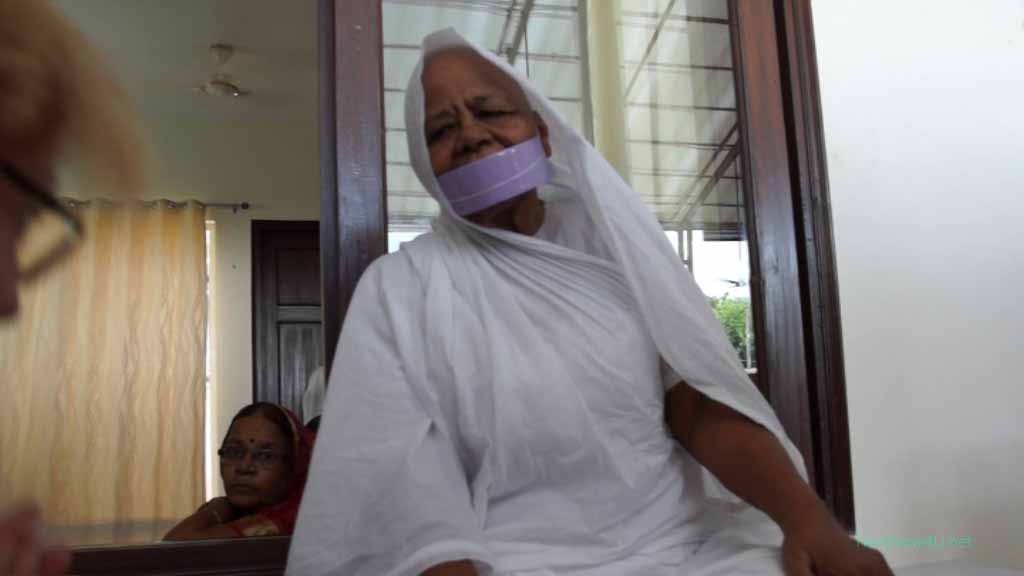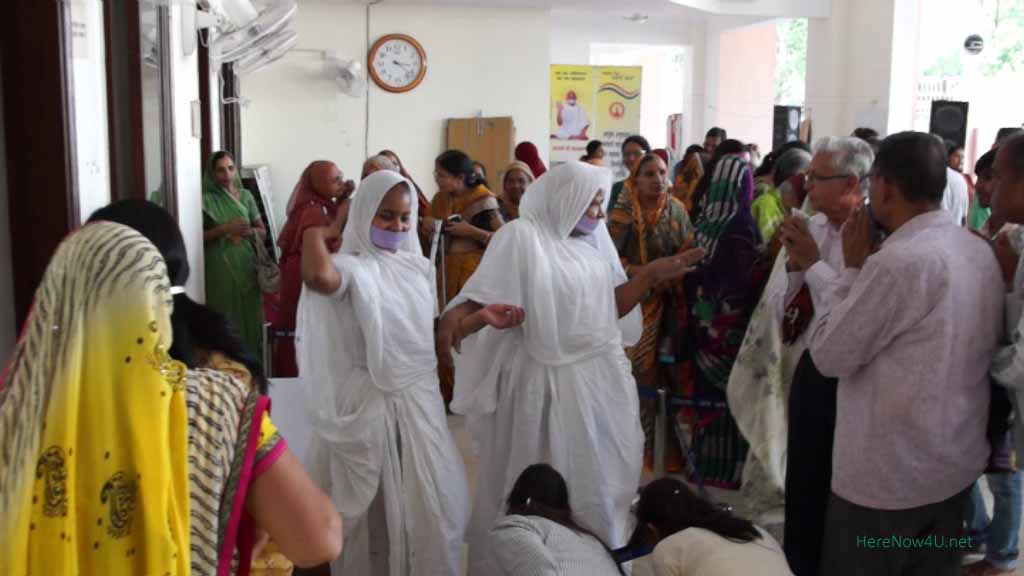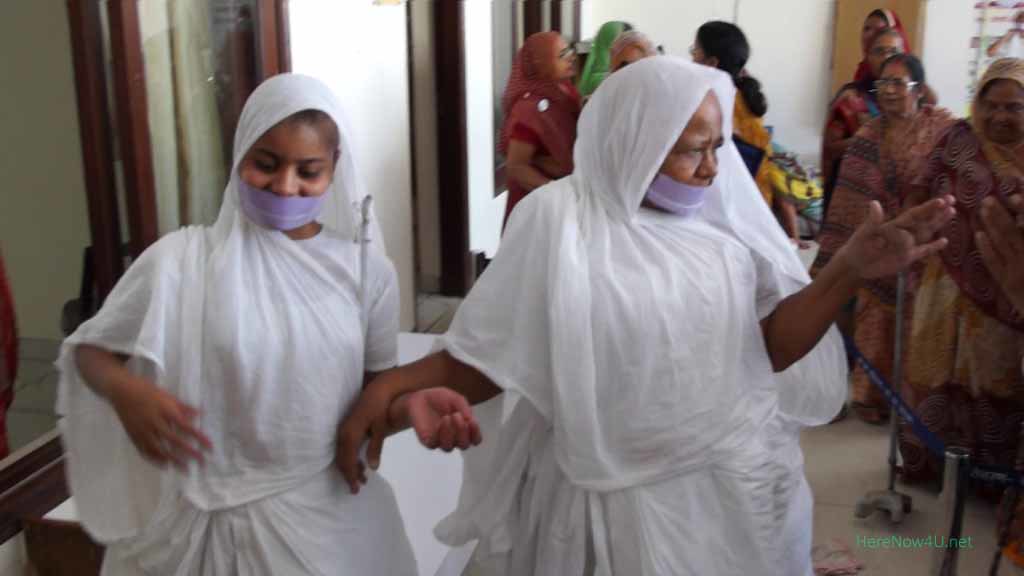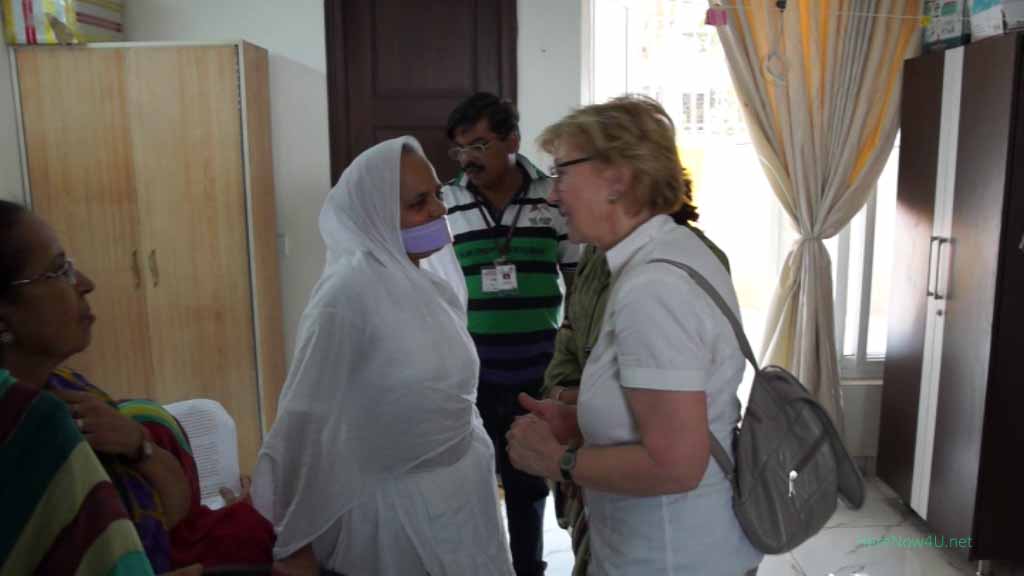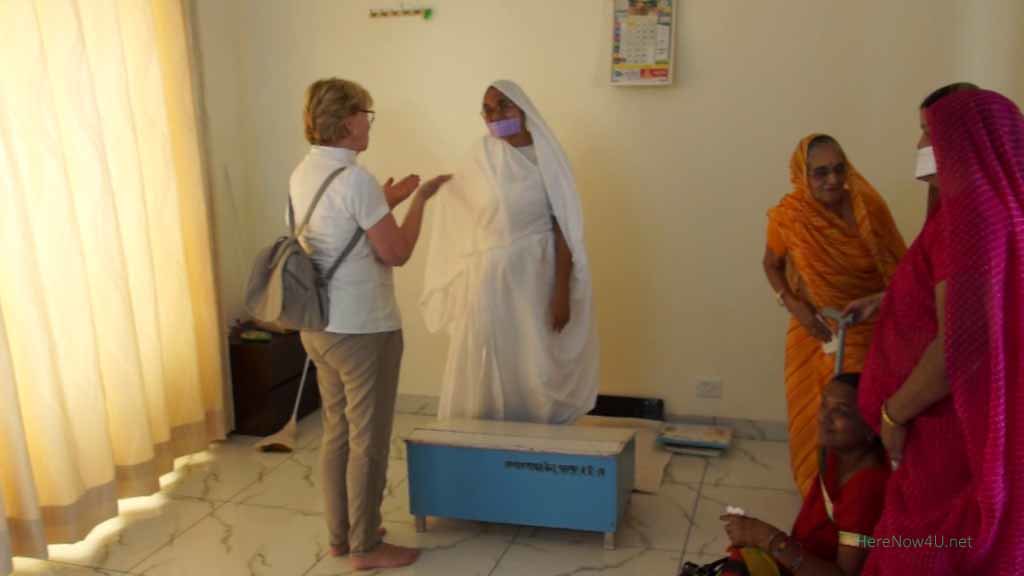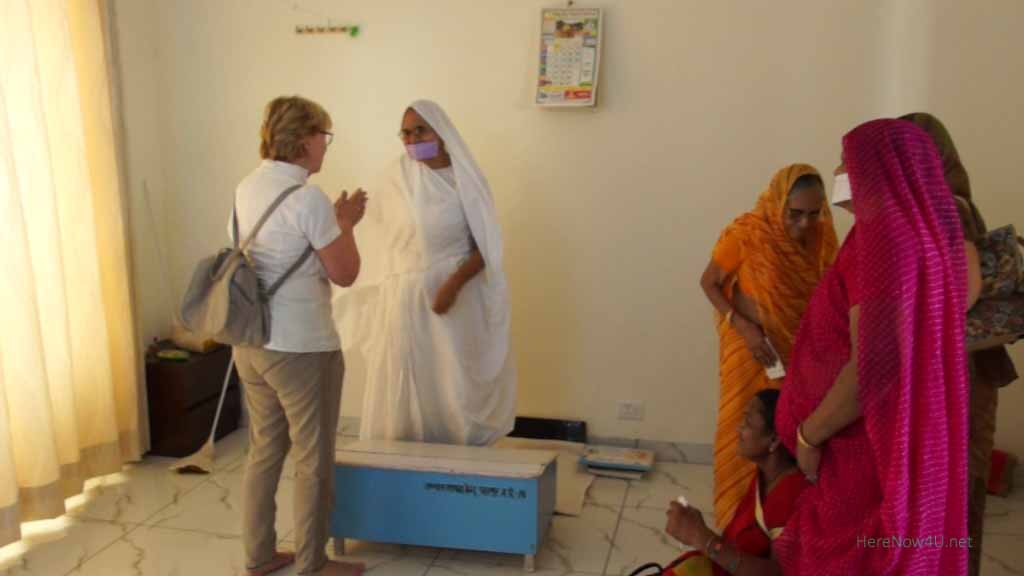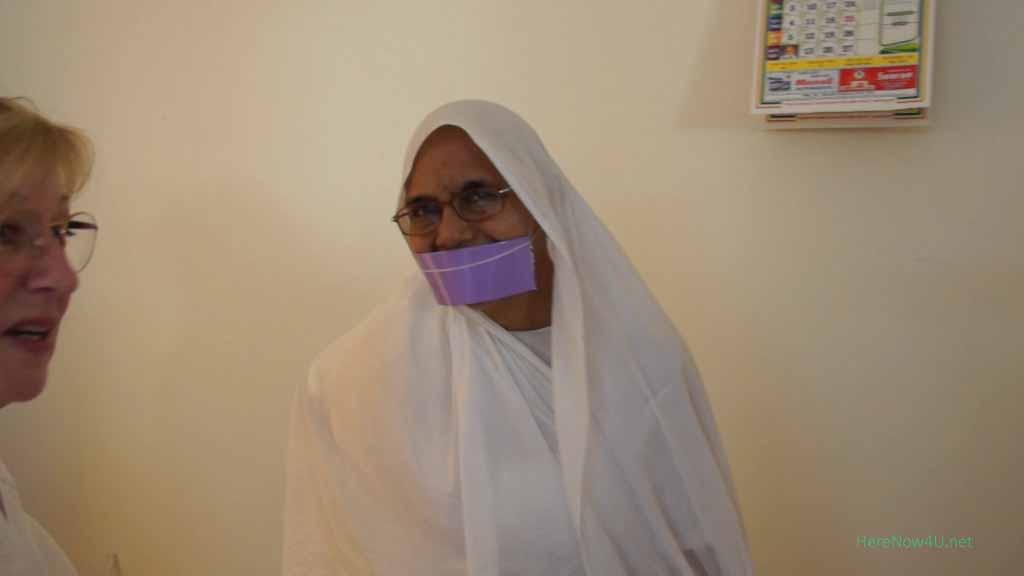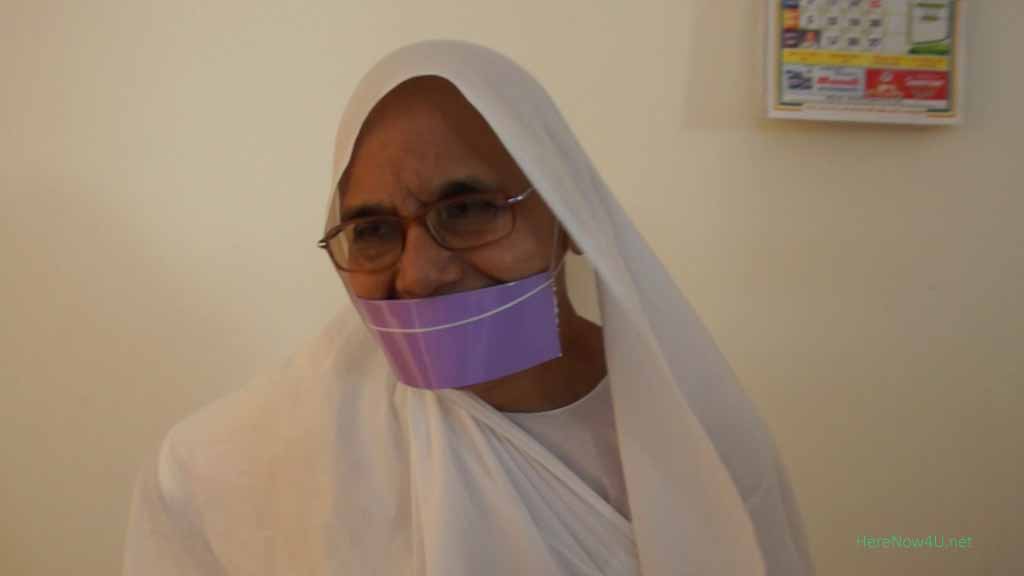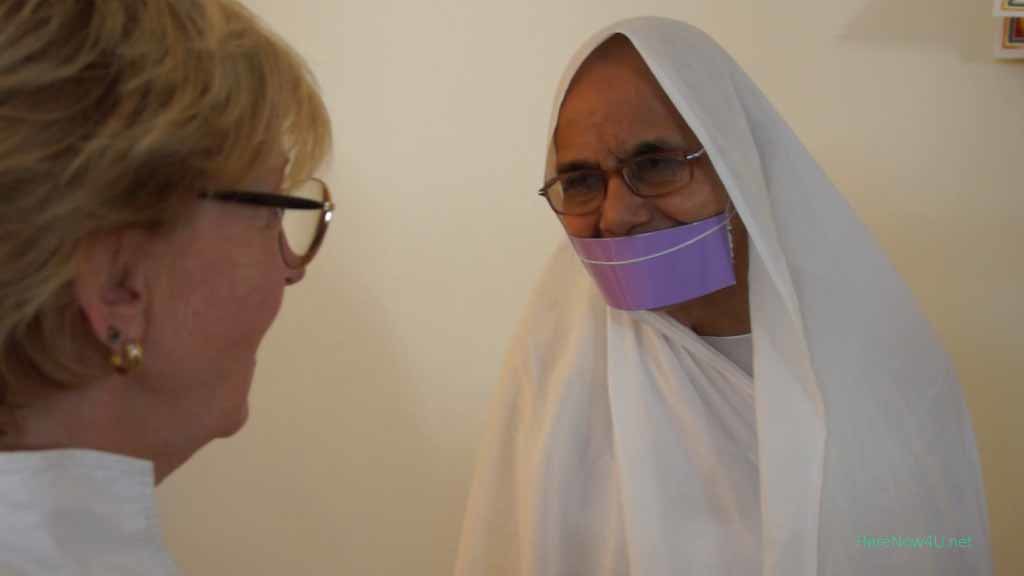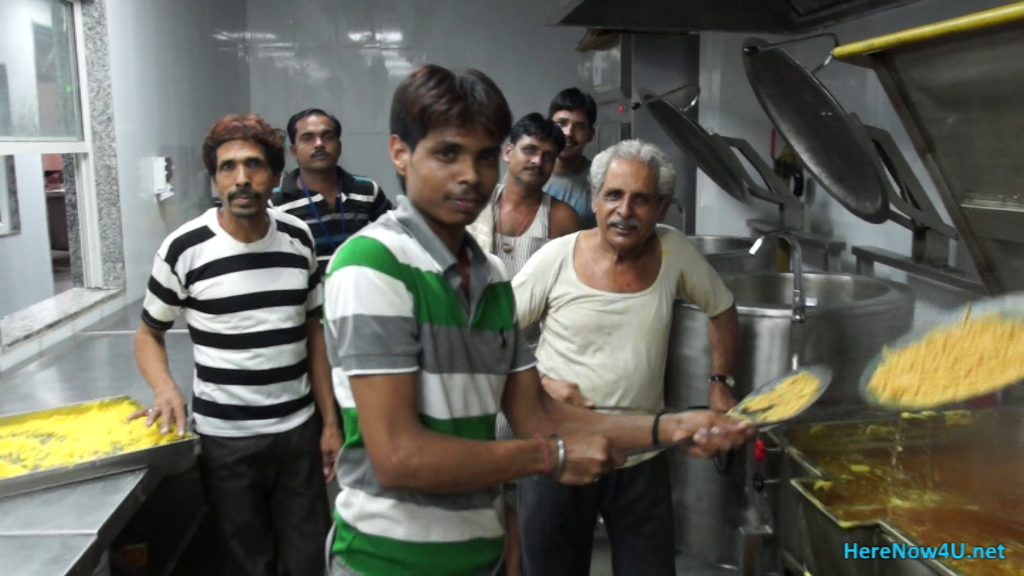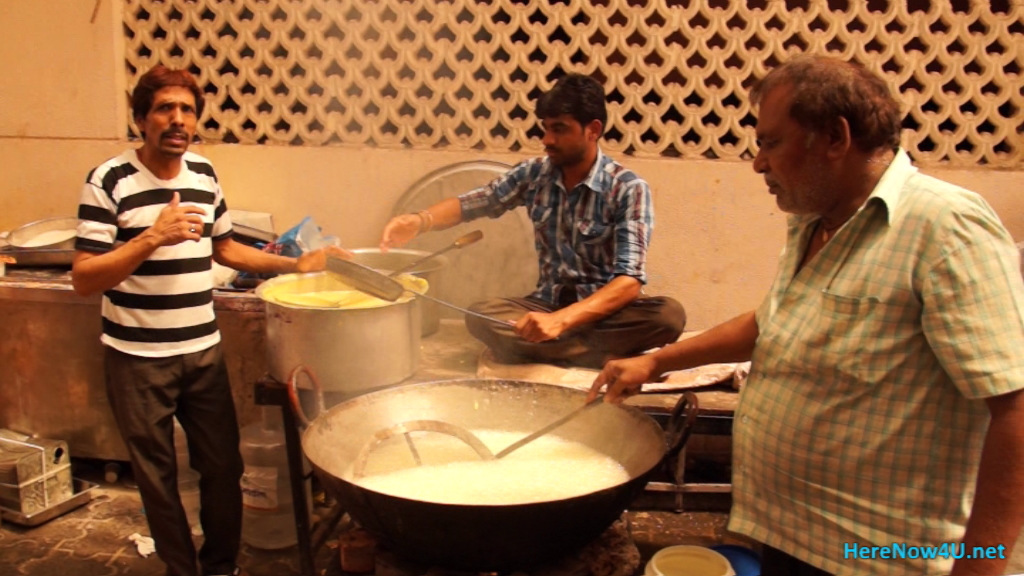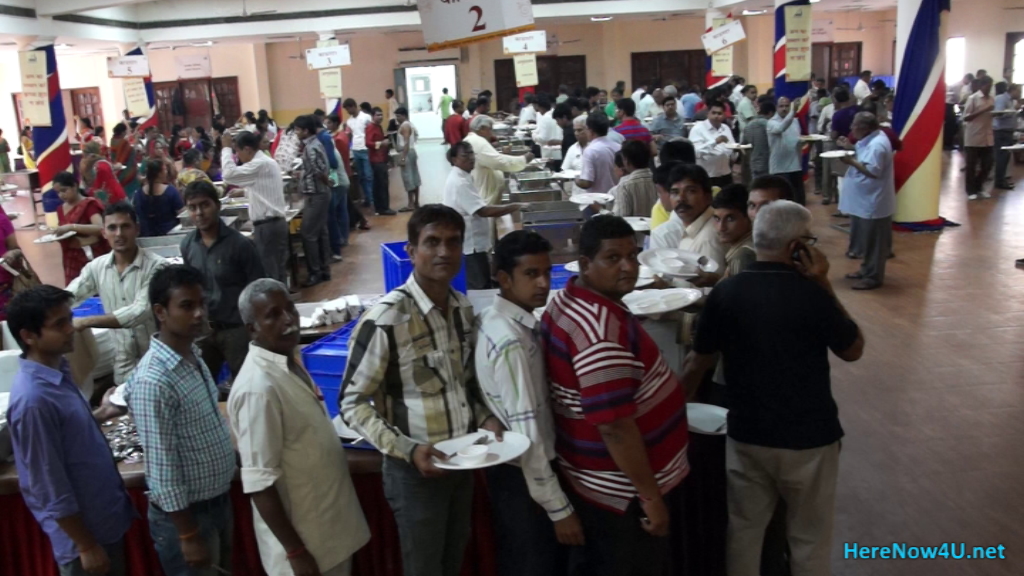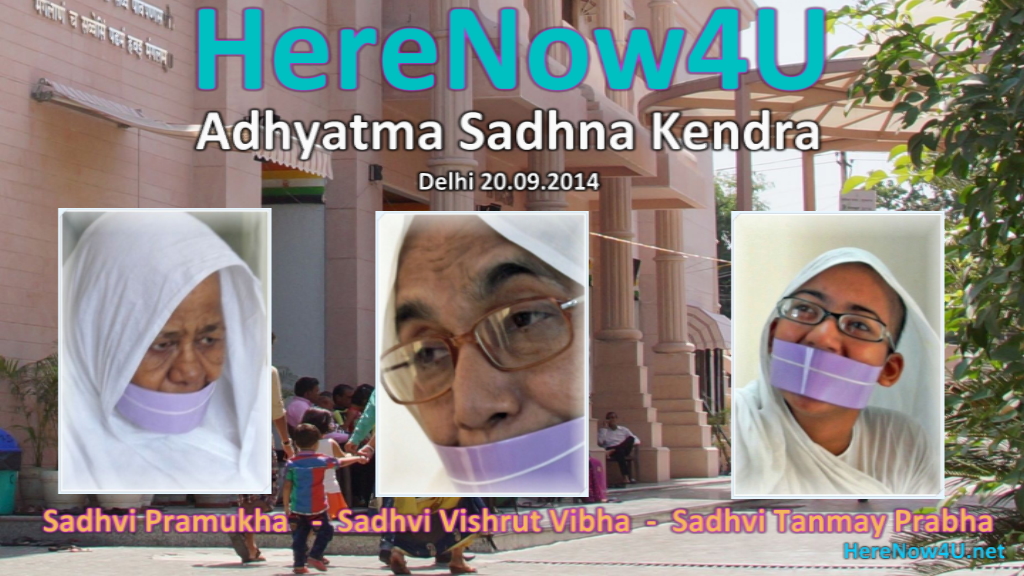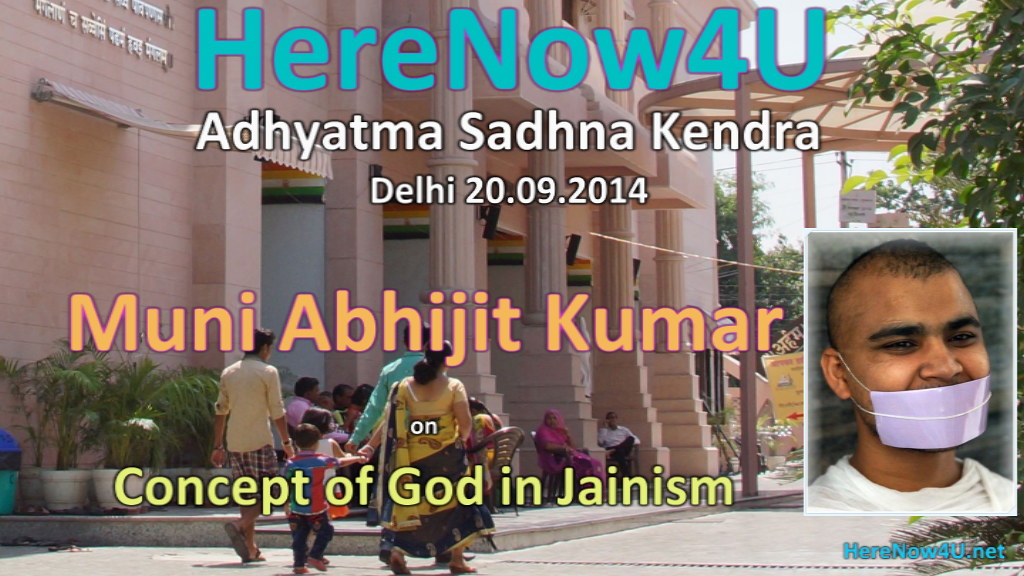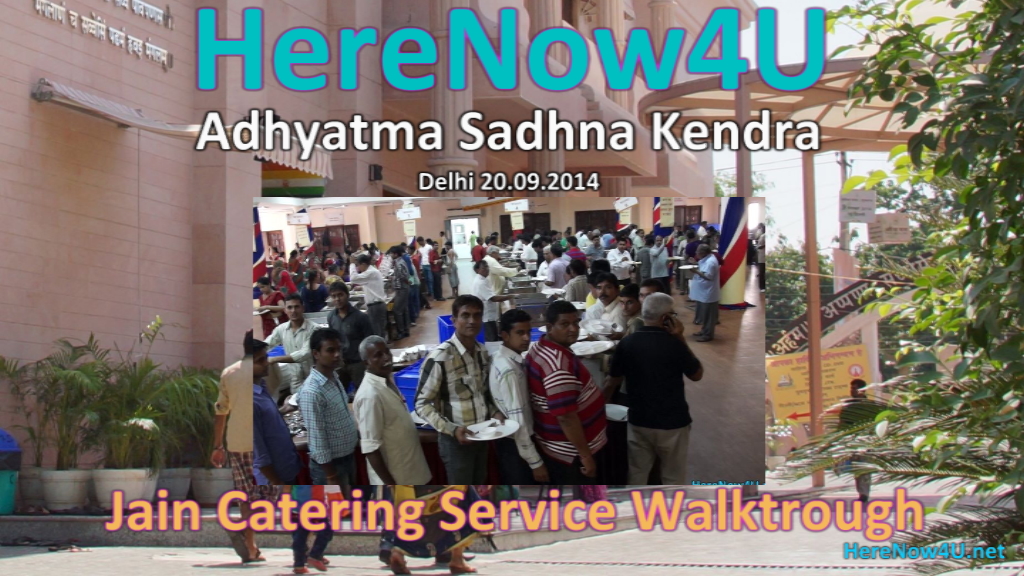
Still rather frequented: The dining hall about 13:00 h
For this day we had no further plans than to make clear how to get next morning to the north eastern edge of Delhi where we wanted to participate in a meeting of Digambara saints. This was a very simple task, as our hosts already had organised a car with driver and only wanted to know some details as time of departure and exact destination. Sometimes things easily get finished. It was lunch time, and we went to the dining hall. The meal was delicious like always. The ticket for a meal could be bought at 50 Indian Rupees only, which was handed over at the respective entry of the buffet. Even in India this was a more symbolic fee affordably for everybody, but not obliging because there had been a payment. The catering was sponsored by the executing company and the Chaturmas organising committee. The volunteers receiving the tickets did not get in touch with the food. Only those putting it with spoons on the plates did. That day we had got the time to notice and admire the well done and meticulously clean performance.
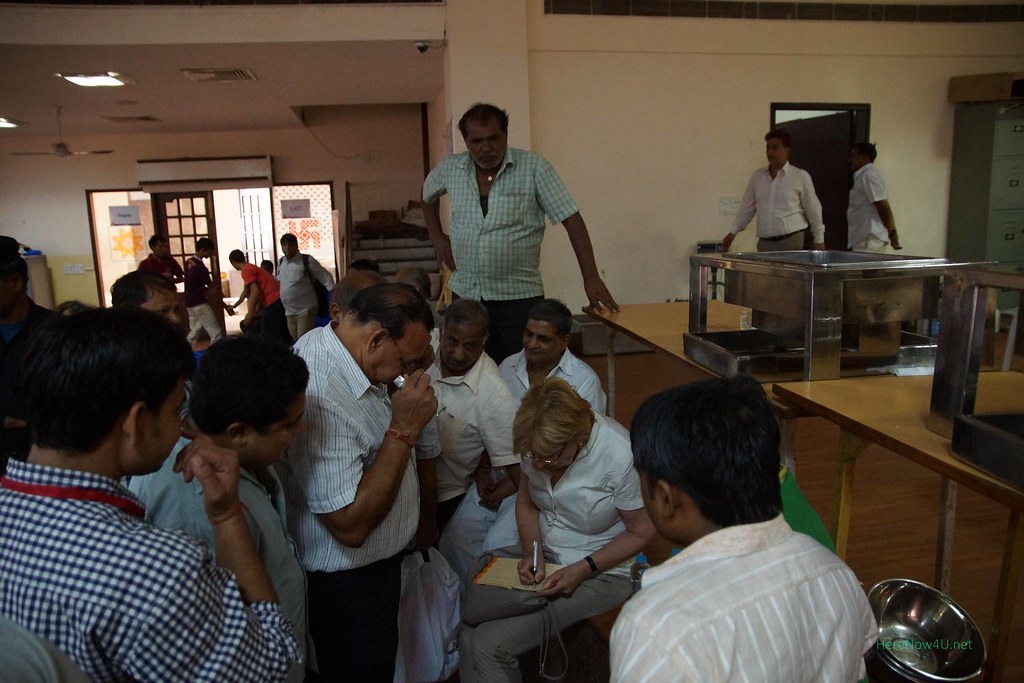
Jeetmal Choraria, manager of Jain Catering, gave some details on his work, while Carla Geerdes surrounded by helpers of the catering team took notes.
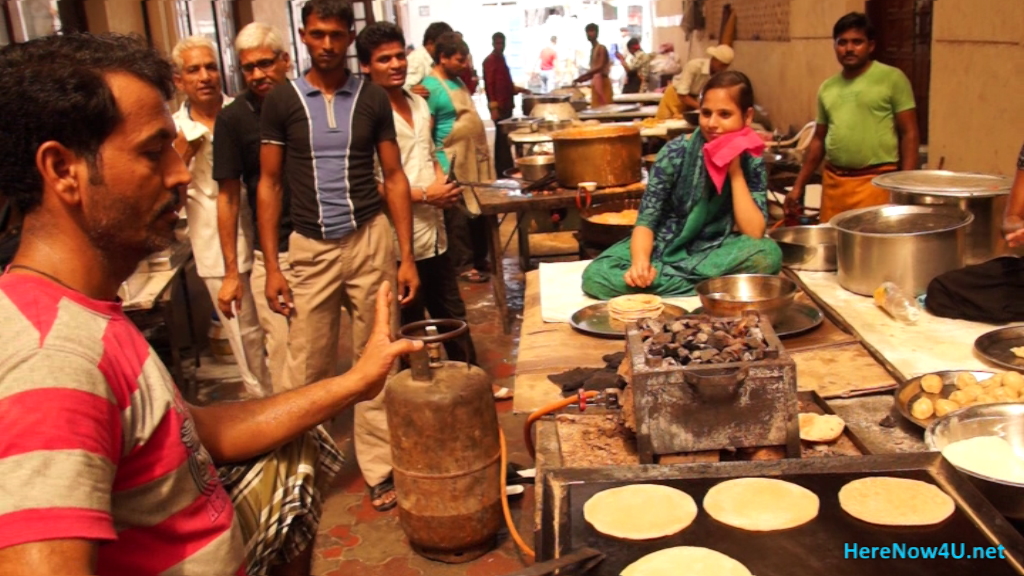
View into kitchen
Christian Geerdes queued up with those waiting for their turn, documenting all with the camera. He moved more and more towards the kitchen, and finally met Jain Catering manager Jeetmal Choraria. The latter not only granted deep views into the preparation of food at a Jain catering service, but also presented his team to us: Narendra Barmecha, Laximipat Bhansali, Lalit Anachiziha, Subhkaran Choraria, and Hanumanmal Bharmecha Chand. They all were visibly exhausted, but very happy on the results of their enormous efforts. About 5,000 people daily took their meals here during the four months of Chaturmas, breakfast from 07:00-09:00h, lunch from 11:00-14:00h, and dinner from 17:00-19:00h. Until 23:00h cleaning, preparing of shopping lists, and taking care for proper storing of deliveries for the next day has to be done. At 06:00h in the morning this schedule starts again. “Actually all of us here are working for 24 hours,” Jeetmal Choraria explained while his colleagues were nodding in agreement. Their boss Jeetmal Choraria himself is a Terapanthi, but his staffers also are well versed with what is expected from the caterers of Jain events. Only by thinking of their labour days we already were feeling exhausted and hoped for them to be able to mobilise the energies needed until November. They all said to be pleased to know that we will report on the assignment they successfully were accomplishing:
Video: Jain Catering Service Walkthrough

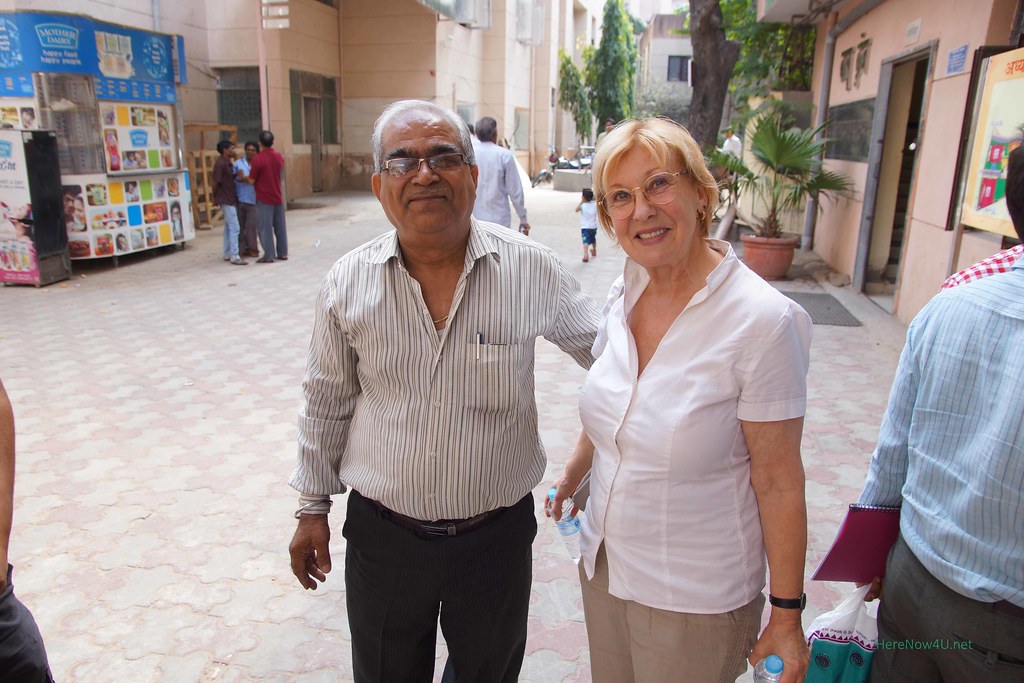
Outside the dining hall we met principal Yaspal Pahuja of Sultanpur Primary School,…
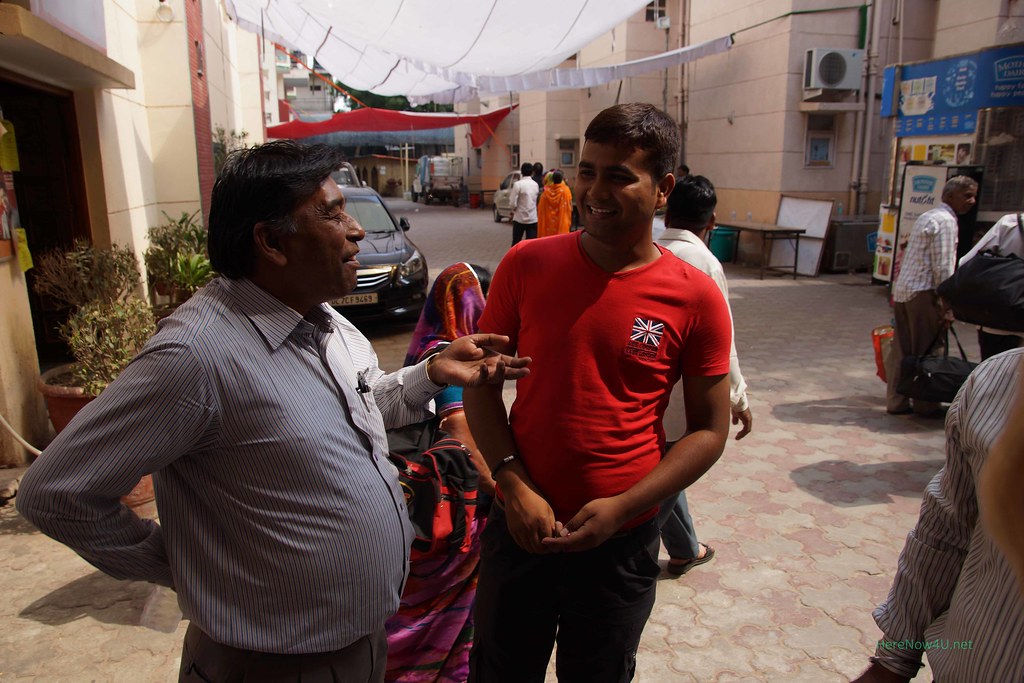
…as well as Sushil Bafana and Navrathan Jain from Sri Dungargarh. They all are very familiar to us since quite some time.

Sadhvi Pramukha Kanak Prabha
The Sadhvis were accommodated in a complex opposite the dining hall. To get there one had to cross an archway and a small courtyard. In front of Sadhvi Pramukha’s room an event was just about to start. Unfortunately there was nobody near to give details on what was happening when we arrived. But to the left of Sadhvi Pramukha Kanak Prabha I discovered Sadhvi Rajul Prabha, former Samani Ramaniya Pragya who is known to me since my first visit to the Terapanthi. Our first encounter was in January 2000 sitting in a jeep together, driving from Ladnun to Taranagar. Sadhvi Rajul Prabha then was Mumukshu sister and I was there for my first stay. At present Sadhvi Rajul Prabha is since some months in the group of Sadhvi Pramukha who is head of two groups of Sadhvis. Sadhvi Rajul Prabha gave sign to meet her in one of the neighboured rooms.

Sadhvi Rajul Prabha
Sadhvi Rajul Prabha apparently had told Sadhvi Pramukha about our short meeting the same day and that both of us wanted to deepen our talk early afeternoon as in the morning we were in a hurry. When she saw me, she whispered something to Sadhvi Pramukha who then looked in my direction and nodded. Finally we met in the room to which Pramukha ji was turning her back. Sadhvi Rajul Prabha knew how eager I was to hear the story behind her Sadhvi Diksha, and she was ready to share it. Together with her sister Sadhvi Chaitanya Prabha, former Samani Sethia Pragya, she was initiated as Sadhvi on 28th November 2013. This was neither preplanned, nor known long in advance as usual.
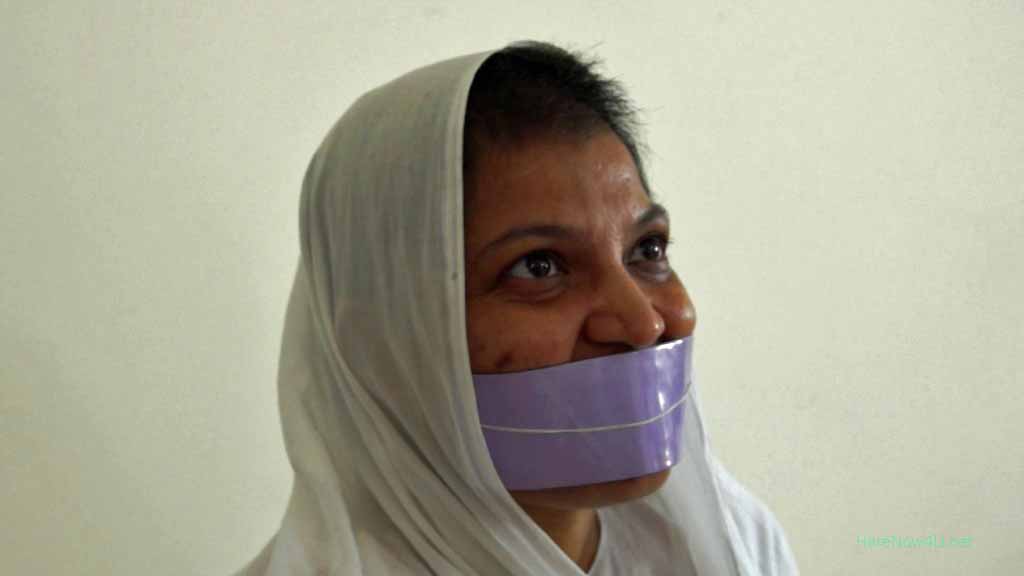
Sadhvi Rajul Prabha speaks on her Sadhvi Diksha.
On this memorable day 39 initiations were scheduled, but 41 would be most auspicious, Sadhvi Rajul Prabha narrated with a benign smile. Spontaneously the two sisters asked HH Acharya Mahashraman for Sadhvi Diksha there, their hearts’ desire since a very long time. To their great joy it all of a sudden was fulfilled faster than thought. Immediately after HH Acharya Mahashraman had consented, the two sisters went in their Samani dresses on stage and left it as Sadhvis. This also was unusual, as Samanis usually are wearing the simple white cotton Sari of the Sadhvis the day of their Sadhvi Diksha. Both of the sisters since then are in the group of Sadhvi Pramukha. This was a record breaking Diksha ceremony anyway, as the record was when Acharya Tulsi once had celebrated 31 Dikshas, Sadhvi Rajul Prabha added.
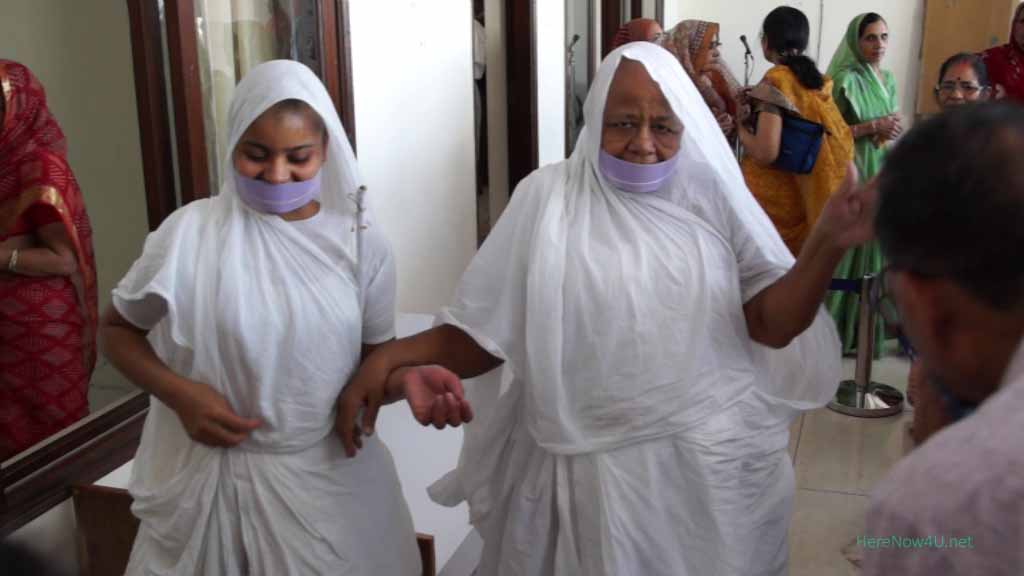
Sadhvi Pramukha Kanak Prabha
Sadhvi Rajul Prabha now is belonging to a team of Sadhvis translating at present the Agama Nayadhammakahao (Jnatadharmakathao) under the guidance of Sadhvi Pramukha Kanak Prabha from Prakrit to Sanskrit. Sadhvi Pramukha is a scholar coordinating since several decades the important translation task of the Sadhvis and the responsible editor and publisher of the books compiled thereof. Sadhvi Pramukha as the general head and Sadhvi Mukhya Niyojika Vishrut Vibha as administrative head are a well-rehearsed team of scholars. All hurdles related to a leadership position in an order with hundreds of well-educated Sadhvis have been overcome by them elegantly and professionally. More than this, with special contentment of all involved. Sadhvi Pramukha’s philosophical and linguistic treasure of knowledge is among her many other extraordinary talents the guideline for the education level of Terapanth Sadhvis.
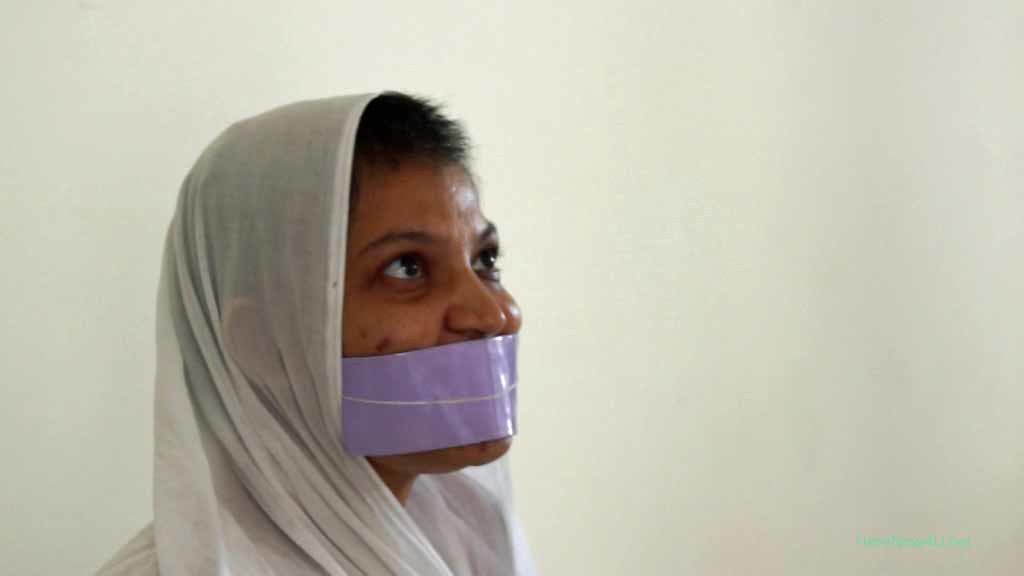
Sadhvi Rajul Prabha on her life as Sadhvi
Translations to Hindi and English also are planned. They are aiming at making available for contemporaries the age-old knowledge compressed in Jain canonical scriptures. In some regard her task based on the original manuscripts corresponds with Sadhvi Rajul Prabha’s own life situation. Since she is Sadhvi in the group of Sadhvi Pramukha Kanak Prabha she feels as if being 2500 years back to the times of Lord Mahavira, living close to nature and being aware of it. She merely uses a small number of material objects and carries light luggage only. To me this sounded metaphor like. Some months after her Sadhvi Diksha she did not use material objects at all, no books, no paper, and no pen. Unexpectedly she had left the area of academic work and contented herself with deep reflections on life. Spiritual inspiration and guidance came to her by thoughts from deep inside. This holistic still enduring process makes her very happy, putting her where she since childhood wanted to be. When speaking on this an inner light came from her eyes, shining on me as well. The English video will give an impression hereon:
Video: Sadhvi Pramukha Kanak Prabha 1


Muni Abhijit Kumar
This afternoon we again had appointment with Muni Abhijit Kumar to continue our talks on his doctoral study. In this context I asked him about the Siddhas. Muni Abhijit Kumar started his discourse with the different concepts of god in different religions. In monotheism the term god emanates from a being having all alone created the world, also known as creation. Jainism denies creation, there are 3 worlds where the souls can stay, the celestial, the hellish and the human world. In the human world celestial and hellish spheres are overlapping. Further there is a fourth location beyond the universe known to us where the Siddhas are dwelling. Siddhas are no more embodied, they are enlightened and liberated souls in their purest form. Celestial beings or gods manifest in an ephemeral and changeable so-called protean body being perceptible for humans as well, but only for a short time. The objective of his research, Muni Abhijit Kumar explicated, is to verify by means of the canonic scriptures that gods living in the celestial world are part of our reality and what impact they have on it. As they are not bound to a cellular body they also are not restricted by its limits. In many religions they are adored like the ancient heroes because of their super natural powers and their access to interstellar space. From their interstellar voyages they very often are submitting messages from the Higher Realities to humanity and also for this are venerated. The subjects Muni Abhijit Kumar raised had a long term impact on us. The dialogue summarised here can be followed in its full length in the video:
Video: Muni Abhijit Kumar

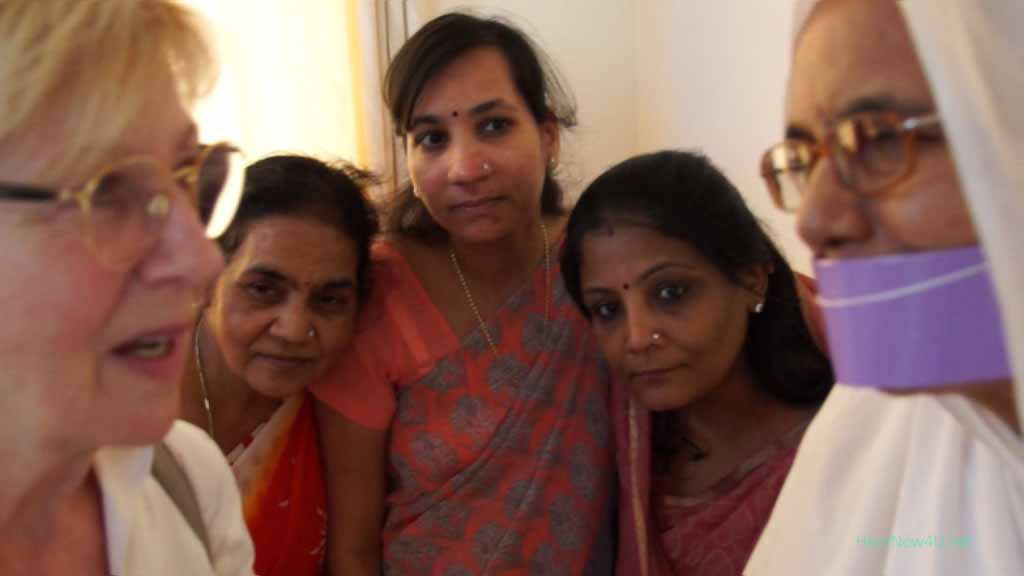
Sadhvi Mukhya Niyojika Vishrut Vibha and Carla Geerdes talking, watched by female lay followers.
After saying good-bye to Muni Abhijit Kumar we hoped to meet Sadhvi Vishrut Vibha. The event in the court yard of Sadhvi Pramukha just was finished, and we were lucky. Sadhvi Mukhya Niyojika Vishrut Vibha was back to her room and she agreed that we spontaneously took a video of her and Sadhvi Tanmay Prabha in her group. In Surat, Gujarat, I met Sadhvi Tanmay Prabha for the first time when she was in the tender age of 11. Shortly before she was initiated as Sadhvi by Acharya Mahapragya and entrusted to Sadhvi Vishrut Vibha. The latter not only very cheerfully cared for the young nun’s well-being, but also supervised her education very successfully. At the age of 15 Sadhvi Tanmay Prabha received in a function for the awardees in the field of education a gold medal for her excellent knowledge of Sanskrit which we had the chance to witness. Now she has started her twenties and is among other a dedicated member of the translation team guided by Sadhvi Vishrut Vibha.
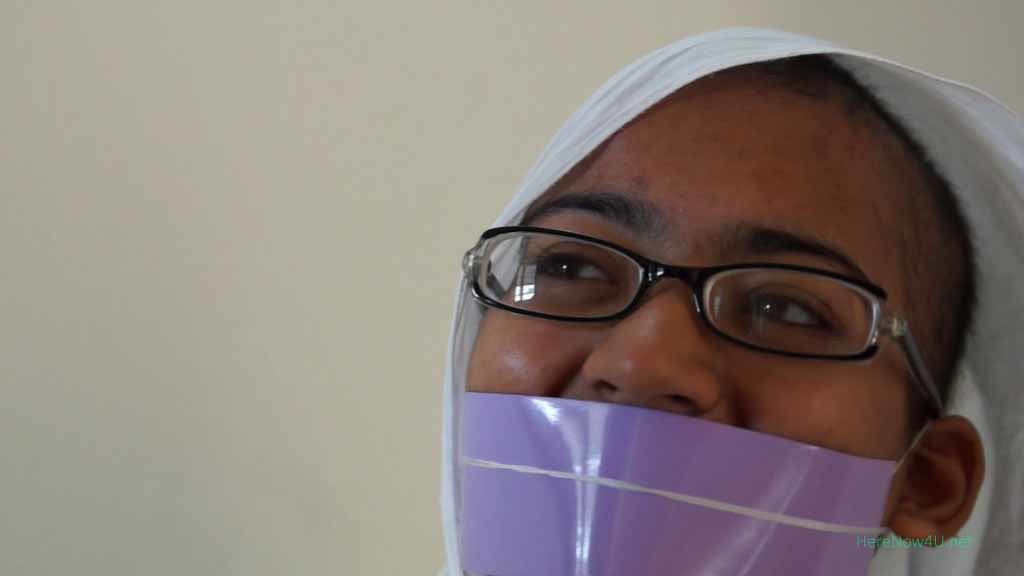
Sadhvi Tanmay Prabha
In the following video one can watch how her eyes are radiating when talking of her mentor:
Video: Sadhvi Pramukha Kanak Prabha 2

 Editor Carla Geerdes
Editor Carla Geerdes


